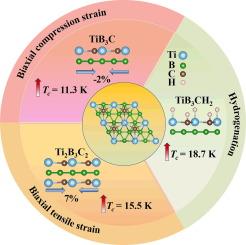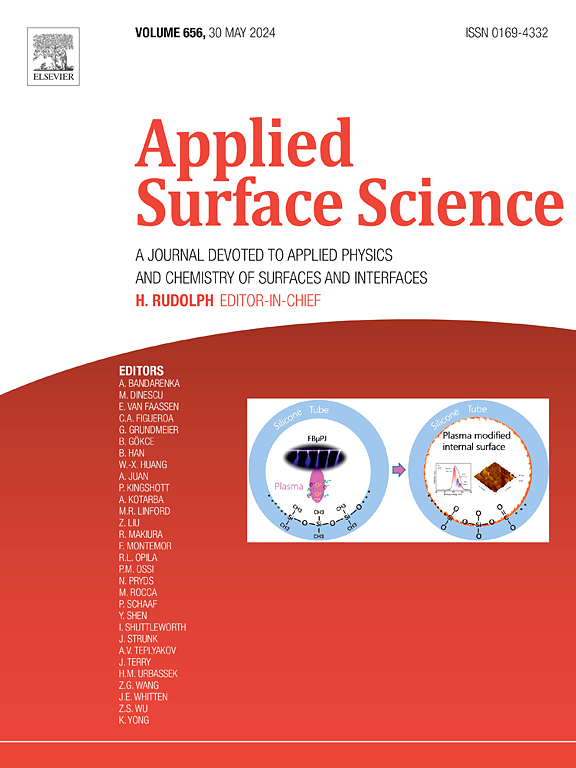Emerging two-dimensional superconductors TiB3C and Ti2B3C2 with monolayer kagome borophene
IF 6.3
2区 材料科学
Q2 CHEMISTRY, PHYSICAL
引用次数: 0
Abstract
Probing emerging two-dimensional (2D) superconductors, including 2D metal borocarbides, has recently garnered significant research interest. However, 2D superconducting Ti-B-C monolayers with unique boron motifs have yet to be discovered. In this study, we conducted a comprehensive investigation of the 2D Ti-B-C system through a first-principles structure search method and identified two stable metallic monolayers, TiB3C and Ti2B3C2, featuring unanticipated kagome boron layers. Electron–phonon coupling (EPC) simulations reveal that both monolayers exhibit phonon-mediated superconductivity, with superconducting transition temperatures (Tc) of 3.2 and 6.5 K, respectively. Furthermore, biaxial compressive strain enhances superconductivity in TiB3C, increasing its Tc to 11.3 K under −2 % strain, while biaxial tensile train elevates the Tc of Ti2B3C2 to 15.5 K under 7 % strain. This improvement in superconductivity is primarily attributed to the increase in EPC strength. Additionally, we designed a novel TiB3CH2 monolayer with metallic characteristics using a hydrogenation strategy. This monolayer exhibits a significantly higher Tc of 18.7 K, chiefly due to strong coupling between Ti 3d electron states near the Fermi level and mid-frequency B-, C-, and H-associated phonons. Our findings provide valuable insights into 2D boron–carbon-based superconductors containing metals and pave the way for designing new 2D superconducting materials.


新兴二维超导体TiB3C和Ti2B3C2与单层kagome硼罗芬
探测新兴的二维(2D)超导体,包括二维金属硼碳化物,最近获得了重要的研究兴趣。然而,具有独特硼基元的二维超导Ti-B-C单层尚未被发现。在本研究中,我们通过第一性原理结构搜索方法对二维Ti-B-C体系进行了全面的研究,发现了两种稳定的金属单层TiB3C和Ti2B3C2,它们具有意想不到的kagome硼层。电子-声子耦合(EPC)模拟表明,两种单层材料均表现出声子介导的超导性,超导转变温度(Tc)分别为3.2和6.5 K。此外,双轴压缩应变增强了TiB3C的超导性,在- 2 %应变下,TiB3C的Tc提高到11.3 K,而双轴拉伸应变在7 %应变下,Ti2B3C2的Tc提高到15.5 K。这种超导性的改善主要是由于EPC强度的增加。此外,我们利用氢化策略设计了一种具有金属特性的新型TiB3CH2单层。该单分子层显示出更高的Tc(18.7 K),主要是由于费米能级附近Ti三维电子态与中频B-、C-和h相关声子之间的强耦合。我们的发现为含金属的二维硼碳基超导体提供了有价值的见解,并为设计新的二维超导材料铺平了道路。
本文章由计算机程序翻译,如有差异,请以英文原文为准。
求助全文
约1分钟内获得全文
求助全文
来源期刊

Applied Surface Science
工程技术-材料科学:膜
CiteScore
12.50
自引率
7.50%
发文量
3393
审稿时长
67 days
期刊介绍:
Applied Surface Science covers topics contributing to a better understanding of surfaces, interfaces, nanostructures and their applications. The journal is concerned with scientific research on the atomic and molecular level of material properties determined with specific surface analytical techniques and/or computational methods, as well as the processing of such structures.
 求助内容:
求助内容: 应助结果提醒方式:
应助结果提醒方式:


